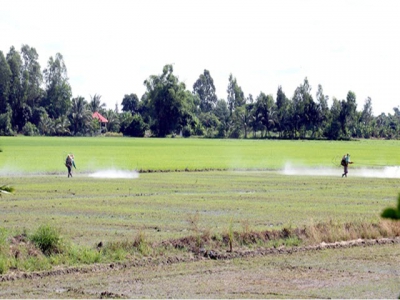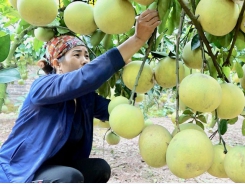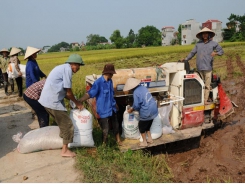Countrys largest rice producing province expands advanced farming models

KIÊN GIANG — The Cửu Long (Mekong) Delta province of Kiên Giang, the country’s largest rice producer, has implemented several advanced extension models for rice cultivation that reduce the quantity of seeds required and use advanced techniques to improve yields and reduce costs.
Farmers tend the autumn - winter rice in Kiên Giang Province’s Tân Hiệp District. — VNA/VNS Photo Lê Huy Hải
In the summer - autumn crop this year the province’s Agriculture Extension Centre trialed three advanced farming models on a total of 128ha in Tân Hiệp, Hòn Đất and Châu Thành districts and Rạch Giá City.
The seeds are sowed using machines, the use of inputs is reduced and advanced farming techniques are used.
The models require 90kg less seeds per hectare than hand-seeding methods, 20kg less nitrogenous fertilisers and two to three times fewer spraying of pesticides per crop.
Their average yield is 7.6 tonnes per hectare, 0.6 tonnes higher than traditional methods while the income is VNĐ6.6 million (US$284) higher.
Other models include smart rice farming and large-scale rice fields.
Under the latter, farmers use the "one must and five reductions" method which involves using certified seeds and reducing seedlings, plant protection chemicals, nitrogenous fertilisers, irrigation, and post-harvest losses.
Đỗ Minh Nhựt, deputy director of the province’s Department of Agriculture and Rural Development, said it has also asked many rice companies to sign contracts with farmers, creating links for rice production, processing and consumption.
“The large-scale rice fields [method] has created rice farming areas with high and steady quality for exports.”
Most of them are in the province’s major rice growing areas and tended by agriculture co-operatives, he said.
The province has 100 such fields with a combined area of 30,670ha, created by pooling together individual farmers’ fields.
They have guaranteed outlets and provide farmers incomes of VNĐ3 million ($130) per hectare per crop higher than through normal farming methods.
Lê Thành Tâm, a farmer whose lands are part of a large-scale rice field in Tân Hiệp District’s Tân Hiệp A Commune, said farmers feel secure when participating in this model because they often have bumper harvests.
Participating farmers use quality rice seeds, sowing seeds in a concerted manner to mitigate the damage caused by brown plant hoppers, rice diseases, drought, and other problems, he said.
The province encourages farmers to adopt sustainable farming standards like Vietnamese and global good agricultural practices (VietGAP and GlobalGAP) and organic farming to improve rice quality and yields.
The province’s Agriculture Extension Centre together with the Cửu Long Rice Research Institute produces certified rice seeds on a total area of 20ha with the participation of 25 members of the Thuận Hòa Agriculture Co-operative in Châu Thành District’s Mong Thọ A Commune.
The centre supports 172 farmers, mostly in the districts of Tân Hiệp, Giang Thành, Hòn Đất and An Minh, in adopting sustainable rice platform standards on a total area of 520ha.
Nhựt said his department has implemented well several projects and programmes to increase the use of certified rice seeds for cultivation.
"It has given farmers training in the ‘one must and five reductions’ method to reduce costs and increase rice value and incomes.”
In the 2020-21 winter – spring rice crop, the province plans to create favourable conditions for co-operatives and rice companies create more large-scale rice fields, especially in its major rice growing areas in the Long Xuyên Quadrangle and west of the Hậu River, according to the department.
In the ongoing autumn – winter crop, the third crop of the year, farmers in Kiên Giang have sowed 90,123ha, 25 per cent more than the province’s target, it said.
Nhựt attributed the increase to the high price of rice and the forecast of lower levels of flooding in the Mekong River this year.
Farmers have so far harvested nearly 57,000ha and achieved an average yield of 5.6 tonnes per hectare.
The province is expected to produce more than 4.54 million tonnes of paddy this year, 5.7 per cent higher than the target, according to the department.
High-quality varieties account for 90 per cent of the province’s total rice output this year.
Related news
Tools

Phối trộn thức ăn chăn nuôi

Pha dung dịch thủy canh

Định mức cho tôm ăn

Phối trộn phân bón NPK

Xác định tỷ lệ tôm sống

Chuyển đổi đơn vị phân bón

Xác định công suất sục khí

Chuyển đổi đơn vị tôm

Tính diện tích nhà kính

Tính thể tích ao




 Prices of fruit and vegetables increase sharply
Prices of fruit and vegetables increase sharply  Improved Vietnamese rice meets EU standards, says top…
Improved Vietnamese rice meets EU standards, says top…